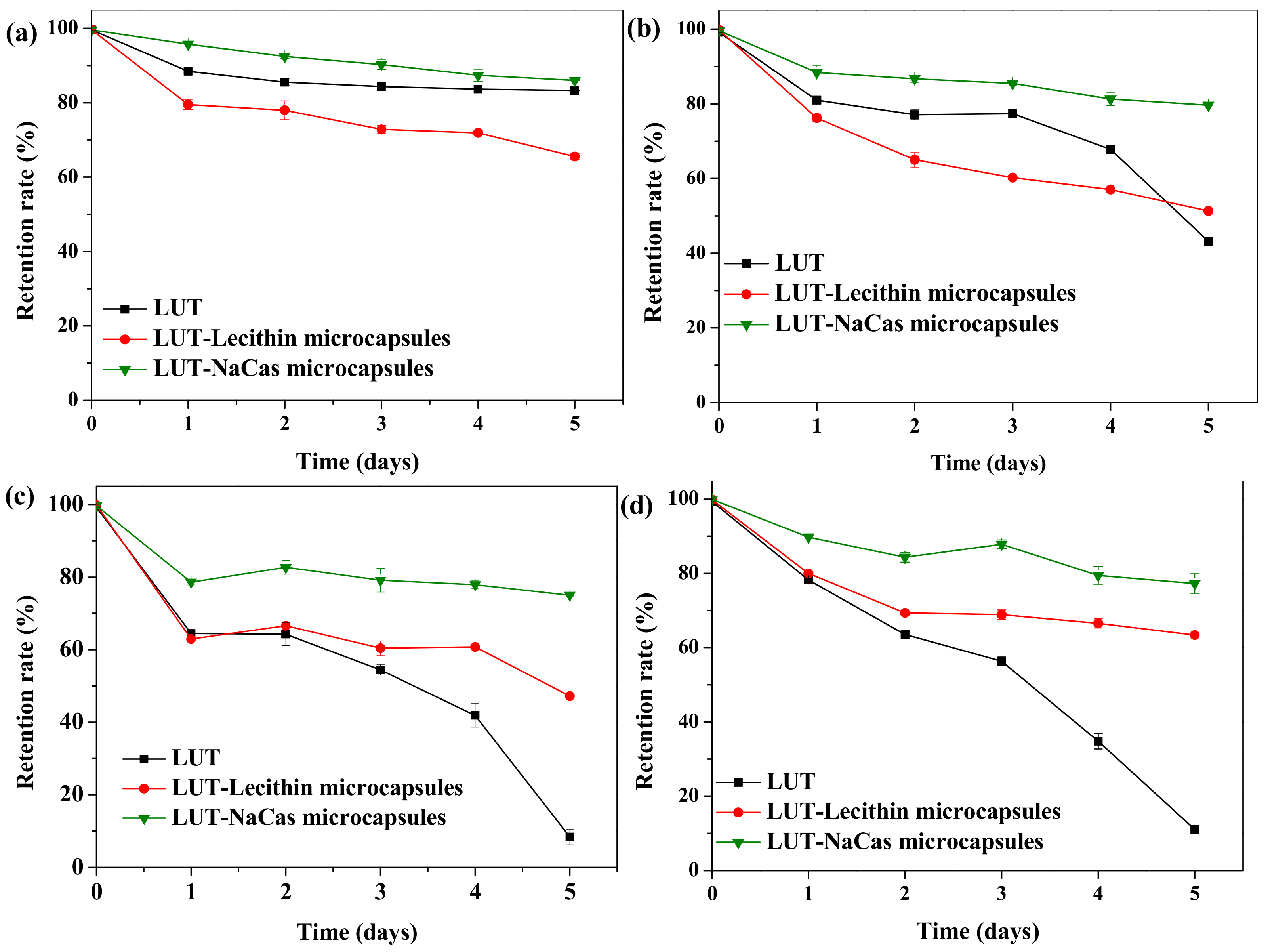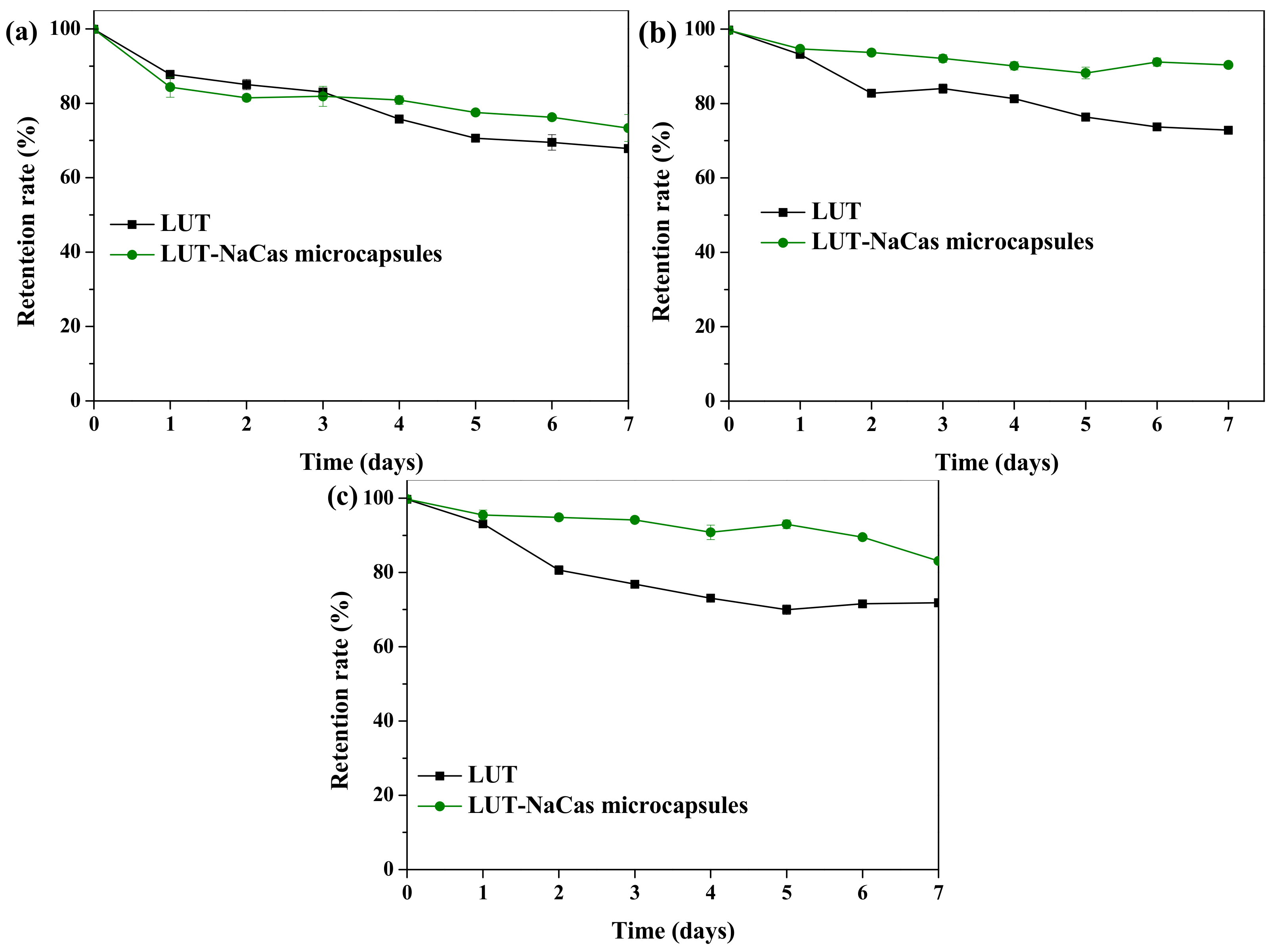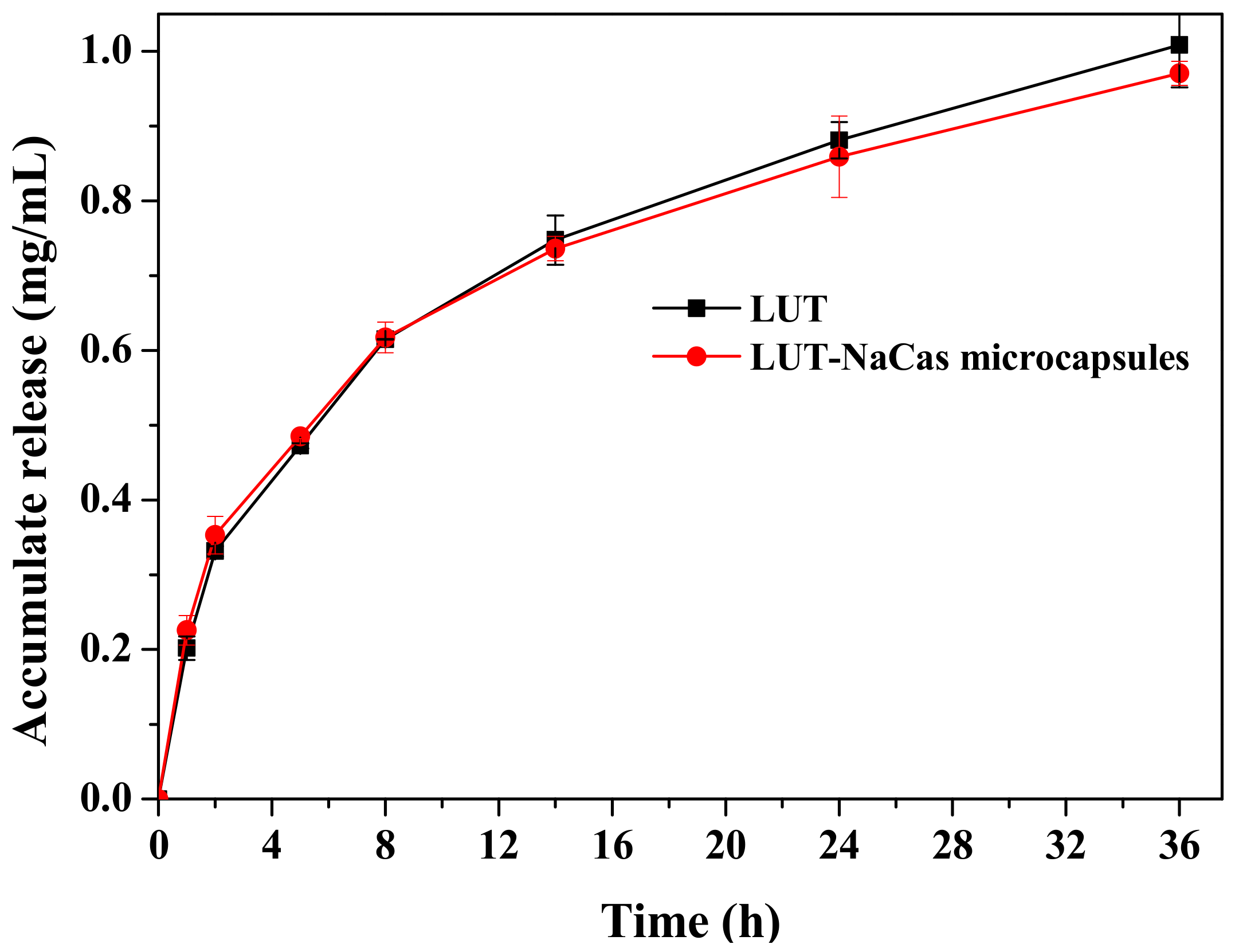Physicochemical Properties of Lutein-Loaded Microcapsules and Their Uptake via Caco-2 Monolayers
Abstract
:1. Introduction
2. Results and Discussion
2.1. Encapsulation Efficiency of Lutein in the Microcapsules
2.2. Water Dispersibility and Microstructure of Lutein and Lutein-Loaded Microcapsules
2.3. Storage Stability of Lutein and Lutein-Loaded Microcapsules
2.3.1. Impact of Temperature
2.3.2. Impact of Lightness
2.3.3. Impact of pH
2.4. FTIR Spectroscopy and DSC
2.5. In Vitro Release Study of the Lutein-Loaded NaCas Microcapsules
2.6. Absorption of Lutein in Caco-2 Cell Monolayers
3. Materials and Methods
3.1. Materials
3.2. Preparation of Lutein-Loaded Microcapsules
3.3. Encapsulation Efficiency
3.4. Scanning Electron Microscopy (SEM)
3.5. Stability of Lutein Microcapsules
3.5.1. Impact of Lightness
3.5.2. Impact of Temperature
3.5.3. Impact of pH
3.6. Fourier Transform Near-Infrared Spectroscopy (FTIR)
3.7. Differential Scanning Calorimetry (DSC)
3.8. Evaluation of In Vitro Release from Dialysis Bag
3.9. Absorption of Lutein in Caco-2 Cell Monolayers
3.10. Statistical Analysis
4. Conclusions
Author Contributions
Funding
Conflicts of Interest
References
- Abdel-Aal, E.S.M.; Akhtar, H.; Zaheer, K.; Ali, R. Dietary sources of lutein and zeaxanthin carotenoids and their role in eye health. Nutrients 2013, 5, 1169–1185. [Google Scholar] [CrossRef] [PubMed]
- Van Lent, D.M.; Leermakers, E.T.; Darweesh, S.K.; Moreira, E.M.; Tielemans, M.J.; Muka, T. The effects of lutein on respiratory health across the life course: A systematic review. Clin. Nutr. ESPEN 2016, 13, e1–e7. [Google Scholar] [CrossRef] [PubMed]
- United States Department of Agriculture Agricultural Research Service National Nutrient Database for Standard Reference. Available online: http://ndb.nal.usda.gov/ndb/nutrients/index (accessed on 3 July 2018).
- Fiedor, J.; Fiedor, L.; Haessner, R.; Scheer, H. Cyclic endoperoxides of beta-carotene, potential pro-oxidants, as products of chemical quenching of singlet oxygen. Biochim. Biophys. Acta Bioenerget. 2005, 1709, 1–4. [Google Scholar] [CrossRef] [PubMed]
- Berman, J.; Zorrilla-López, U.; Farré, G.; Zhu, C.; Sandmann, G.; Twyman, R.M.; Capell, T.; Christou, P. Nutritionally important carotenoids as consumer products. Phytochem. Rev. 2015, 14, 727–743. [Google Scholar] [CrossRef]
- Sujak, A.; Gabrielska, J.; Grudziński, W.; Borc, R.; Mazurek, P.; Gruszecki, W.I. Lutein and zeaxanthin as protectors of lipid membranes against oxidative damage: The structural aspects. Arch. Biochem. Biophys. 1999, 371, 301–307. [Google Scholar] [CrossRef] [PubMed]
- Gale, C.R.; Hall, N.F.; Phillips, D.I.; Martyn, C.N. Lutein and zeaxanthin status and risk of age-related macular degeneration. Investig. Ophthalmol. Vis. Sci. 2003, 44, 2461–2465. [Google Scholar] [CrossRef]
- Krinsky, N.I.; Landrum, J.T.; Bone, R.A. Biologic mechanisms of the protective role of lutein and zeaxanthin in the eye. Annu. Rev. Nutr. 2003, 23, 171–201. [Google Scholar] [CrossRef] [PubMed]
- Nagao, A. Bioavailability of dietary carotenoids: Intestinal absorption and metabolism. Jpn. Agric. Res. Q. 2014, 48, 385–391. [Google Scholar] [CrossRef]
- Joint FAO/WHO Expert Committee on Food Additives. Evaluation of Certain Food Additives: Sixty-Third Report of the Joint FAO/WHO Expert Committee on Food Additives; WHO Technical Report; WHO: Geneva, Switzerland, 2005. [Google Scholar]
- Frede, K.; Henze, A.; Khalil, M.; Baldermann, S.; Schweigert, F.J.; Rawel, H. Stability and cellular uptake of lutein-loaded emulsions. J. Funct. Foods 2014, 8, 118–127. [Google Scholar] [CrossRef]
- Firdous, A.P.; Sindhu, E.R.; Kuttan, R. Hepato-protective potential of carotenoid meso-zeaxanthin against paracetamol, CCl4 and ethanol induced toxicity. Indian J. Exp. Biol. 2011, 49, 44–49. [Google Scholar] [PubMed]
- Liu, C.H.; Lai, K.Y.; Wu, W.C.; Chen, Y.J.; Lee, W.S.; Hsu, C.Y. In vitro scleral lutein distribution by cyclodextrin containing nanoemulsions. Chem. Pharm. Bull. 2015, 63, 59–67. [Google Scholar] [CrossRef] [PubMed]
- Yoo, J.H.; Thapa, S.P.; Lee, E.S.; Balakrishnan, P. Novel self-nanoemulsifying drug delivery system for enhanced solubility and dissolution of lutein. Arch. Pharmacal Res. 2010, 33, 417–426. [Google Scholar] [CrossRef] [PubMed]
- Niamprem, P.; Rujivipat, S.; Tiyaboonchai, W. Development and characterization of lutein-loaded SNEDDS for enhanced absorption in Caco-2 cells. Pharm. Dev. Tech. 2014, 19, 735–742. [Google Scholar] [CrossRef] [PubMed]
- Xia, F.; Hu, D.; Jin, H.; Zhao, Y.; Liang, J. Preparation of lutein proliposomes by supercritical anti-solvent technique. Food Hydrocoll. 2012, 26, 456–463. [Google Scholar] [CrossRef]
- Tan, C.; Xia, S.; Xue, J.; Xie, J.; Feng, B.; Zhang, X. Liposomes as vehicles for lutein: Preparation, stability, liposomal membrane dynamics, and structure. J. Agric. Food Chem. 2013, 61, 8175–8184. [Google Scholar] [CrossRef] [PubMed]
- Chen, T.; Zhang, Y.; Abbas, S.; Feng, B.; Zhang, X.; Xia, S. Modulation of the carotenoid bioaccessibility through liposomal encapsulation. Coll. Surf. B Biointerfaces 2014, 123, 692–700. [Google Scholar]
- Liu, C.H.; Chiu, H.C.; Wu, W.C.; Sahoo, S.L.; Hsu, C.Y. Novel lutein loaded lipid nanoparticles on porcine corneal distribution. J. Ophthalmol. 2014, 2014, 304694. [Google Scholar] [CrossRef] [PubMed]
- Arunkumar, R.; Prashanth, K.V.; Manabe, Y.; Hirata, T.; Sugawara, T.; Dharmesh, S.M.; Baskaran, V. Biodegradable poly(lactic-co-glycolic acid)-polyethylene glycol nanocapsules: An efficient carrier for improved solubility, bioavailability, and anticancer property of lutein. J. Pharm. Sci. 2015, 104, 2085–2093. [Google Scholar] [CrossRef] [PubMed]
- Apanasenko, I.E.; Selyutina, O.Y.; Polyakov, N.E.; Suntsova, L.P.; Meteleva, E.S.; Dushkin, A.V.; Vachali, P.; Bernstein, P.S. Solubilization and stabilization of macular carotenoids by water soluble oligosaccharides and polysaccharides. Arch. Biochem. Biophys. 2015, 572, 58–65. [Google Scholar] [CrossRef] [PubMed] [Green Version]
- Kuang, P.; Zhang, H.; Bajaj, P.R.; Yuan, Q.; Tang, J.; Chen, S.; Sablani, S.S. Physicochemical properties and storage stability of lutein microcapsules prepared with maltodextrins and sucrose by spray drying. J. Food Sci. 2015, 80, E359–E369. [Google Scholar] [CrossRef] [PubMed]
- Arunkumar, R.; Harish Prashanth, K.V.; Baskaran, V. Promising interaction between nanoencapsulated lutein with low molecular weight chitosan: Characterization and bioavailability of lutein in vitro and in vivo. Food Chem. 2013, 141, 327–337. [Google Scholar] [CrossRef] [PubMed]
- Zhao, C.; Cheng, H.; Jiang, P.; Yao, Y.; Han, J. Preparation of lutein-loaded particles for improving solubility and stability by Polyvinylpyrrolidone (PVP) as an emulsion-stabilizer. Food Chem. 2014, 156, 123–128. [Google Scholar] [CrossRef] [PubMed]
- Matos, M.; Gutiérrez, G.; Iglesias, O.; Coca, J.; Pazos, C. Characterization, stability and rheology of highly concentrated monodisperse emulsions containing lutein. Food Hydrocoll. 2015, 49, 156–163. [Google Scholar] [CrossRef]
- Nalawade, P.B.; Gajjar, A.K. Microencapsulation of lutein extracted from marigold flowers (Tagetes erecta L.) using full factorial design. J. Drug Deliv. Sci. Technol. 2016, 33, 75–87. [Google Scholar] [CrossRef]
- Gharsallaoui, A.; Roudaut, G.; Chambin, O.; Voilley, A.; Saurel, R. Applications of spray-drying in microencapsulation of food ingredients: An overview. Food Res. Int. 2007, 40, 1107–1121. [Google Scholar] [CrossRef]
- Gallardo, G.; Guida, L.; Martinez, V.; López, M.C.; Bernhardt, D.; Blasco, R.; Pedroza-Islas, R.; Hermida, L.G. Microencapsulation of linseed oil by spray drying for functional food application. Food Res. Int. 2013, 52, 473–482. [Google Scholar] [CrossRef]
- Liu, F.; Ma, C.; Gao, Y.; McClements, D.J. Food-grade covalent complexes and their application as nutraceutical delivery systems: A review. Compr. Rev. Food. Sci. F. 2017, 16, 76–95. [Google Scholar] [CrossRef]
- Pan, K.; Zhong, Q.; Baek, S.J. Enhanced dispersibility and bioactivity of curcumin by encapsulation in casein nanocapsules. J. Agric. Food Chem. 2013, 61, 6036–6043. [Google Scholar] [CrossRef] [PubMed]
- Demetriades, K.; Mcclements, D.J. Influence of pH and heating on physicochemical properties of whey protein-stabilized emulsions containing a nonionic surfactant. J. Agric. Food Chem. 1998, 46, 3936–3942. [Google Scholar] [CrossRef]
- Darewicz, M.; Dziuba, J.; Dziuba, M.; Śmietana, Z. Functional properties and biological activities of bovine casein proteins and peptides. Pol. J. Food Nutr. Sci. 2006, 15, 79–86. [Google Scholar]
- O’Kennedy, B.T.; Mounsey, J.S. Control of heat-induced aggregation of whey proteins using casein. J. Agric. Food Chem. 2006, 54, 5637–5642. [Google Scholar] [CrossRef] [PubMed]
- Zhu, X. Interface properties of lecithin in microencapsulation of β-carotene. J. Chin. Inst. Food Sci. Technol. 2003, 3, 36–40. (In Chinese) [Google Scholar]
- Liu, F.; Wang, D.; Sun, C.; McClements, D.J.; Gao, Y. Utilization of interfacial engineering to improve physicochemical stability of β-carotene emulsions: Multilayer coatings formed using protein and protein–polyphenol conjugates. Food Chem. 2016, 205, 129–139. [Google Scholar] [CrossRef] [PubMed]
- Mcclements, D.J. Protein-stabilized emulsions. Curr. Opin. Coll. Interface Sci. 2005, 9, 305–313. [Google Scholar] [CrossRef]
- Liu, F.; Ma, D.; Luo, X.; Zhang, Z.; He, L.; Gao, Y.; Mcclements, D.J. Fabrication and characterization of protein-phenolic conjugate nanoparticles for co-delivery of curcumin and resveratrol. Food Hydrocoll. 2018, 79, 450–461. [Google Scholar] [CrossRef]
- Yi, J.; Lam, T.I.; Yokoyama, W.; Cheng, L.W.; Zhong, F. Beta-carotene encapsulated in food protein nanoparticles reduces peroxyl radical oxidation in Caco-2 cells. Food Hydrocoll. 2015, 43, 31–40. [Google Scholar] [CrossRef]
- Mastromatteo, M.; Barbuzzi, G.; Conte, A.; Nobile, M.A.D. Controlled release of thymol from zein based film. Innov. Food Sci. Emerg. Technol. 2009, 10, 222–227. [Google Scholar] [CrossRef]
- Liu, X.; Sun, Q.; Wang, H.; Zhang, L.; Wang, J.Y. Microspheres of corn protein, zein, for an ivermectin drug delivery system. Biomaterials 2005, 26, 109–115. [Google Scholar] [CrossRef] [PubMed]
- Yi, J.; Li, Y.; Zhong, F.; Yokoyama, W. The physicochemical stability and invitro bioaccessibility of beta-carotene in oil-in-water sodium caseinate emulsions. Food Hydrocoll. 2014, 35, 19–27. [Google Scholar] [CrossRef]
- Klang, V.; Valenta, C. Lecithin-based nanoemulsions. J. Drug Deliv. Sci. Technol. 2011, 21, 55–76. [Google Scholar] [CrossRef]
- Duan, X.; Li, M.; Shao, J. Effect of oxidative modification on structural and foaming properties of egg white protein. Food Hydrocoll. 2017, 75, 223–228. [Google Scholar] [CrossRef]
- Chen, J.; Li, F.; Lou, Y.; Chen, J.; Zeng, Z.; Wu, L. High performance liquid chromatography(HPLC) method for determining the content of lutein. Guangdong Chem. Industry 2015, 15, 210–211. (In Chinese) [Google Scholar]
- Kamil, A.; Smith, D.E.; Blumberg, J.B.; Astete, C.; Sabliov, C.; Chen, C.Y.O. Bioavailability and biodistribution of nanodelivered lutein. Food Chem. 2016, 192, 915–923. [Google Scholar] [CrossRef] [PubMed]
Sample Availability: Samples of the compounds (lutein-loaded lecithin microcapsules and lutein-loaded NaCas microcapsules) are available from the authors. |






© 2018 by the authors. Licensee MDPI, Basel, Switzerland. This article is an open access article distributed under the terms and conditions of the Creative Commons Attribution (CC BY) license (http://creativecommons.org/licenses/by/4.0/).
Share and Cite
Zhao, T.; Liu, F.; Duan, X.; Xiao, C.; Liu, X. Physicochemical Properties of Lutein-Loaded Microcapsules and Their Uptake via Caco-2 Monolayers. Molecules 2018, 23, 1805. https://doi.org/10.3390/molecules23071805
Zhao T, Liu F, Duan X, Xiao C, Liu X. Physicochemical Properties of Lutein-Loaded Microcapsules and Their Uptake via Caco-2 Monolayers. Molecules. 2018; 23(7):1805. https://doi.org/10.3390/molecules23071805
Chicago/Turabian StyleZhao, Tong, Fuguo Liu, Xiang Duan, Chunxia Xiao, and Xuebo Liu. 2018. "Physicochemical Properties of Lutein-Loaded Microcapsules and Their Uptake via Caco-2 Monolayers" Molecules 23, no. 7: 1805. https://doi.org/10.3390/molecules23071805




